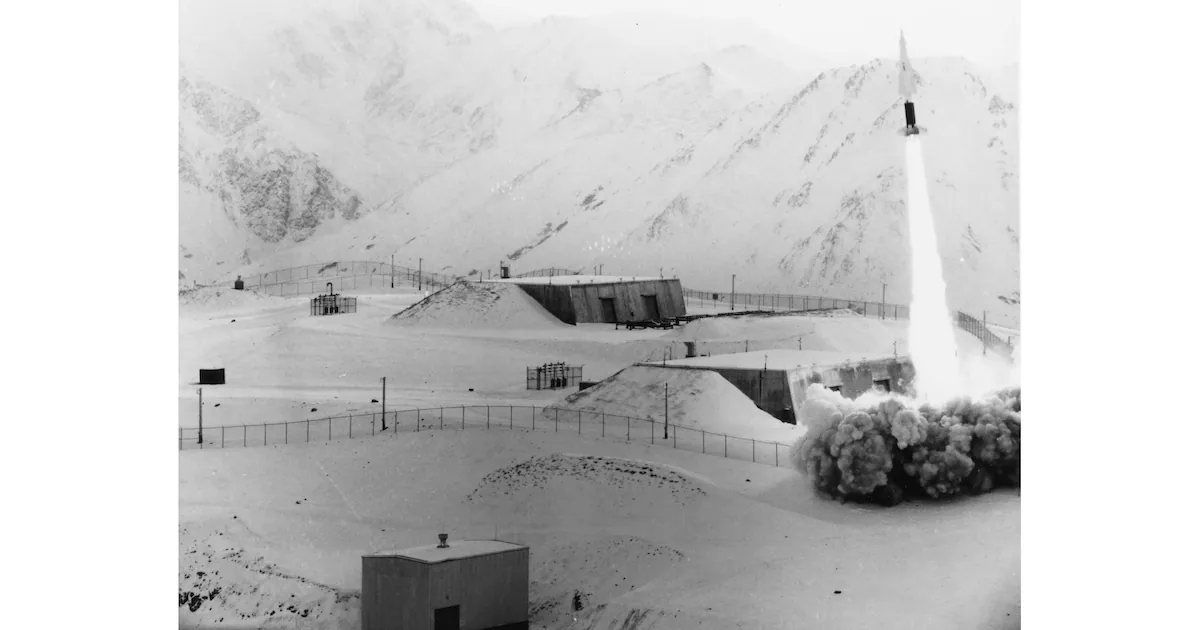Copyright Anchorage Daily News

Part of a continuing weekly series on Alaska history by local historian David Reamer. Have a question about Anchorage or Alaska history or an idea for a future article? Go to the form at the bottom of this story. The missile, a deadly instrument of war, trailed fire over greater Anchorage. The homesteaders displaced from their homes watched and cheered. The people in the city below gazed upwards, their emotions dominated by pride and awe. Children were freed from their desks and allowed outside to observe the moment. Bob Atwood, editor of the Anchorage Daily Times, described the event as “another important ‘first’ for this city.” It was a Nike Hercules, a primarily surface-to-air missile birthed in the early years of the Cold War. In Alaska, as elsewhere, they were intended as a mid- to long-range defense against Soviet aerial assaults. Typically capped with a nuclear warhead, they measured 41 feet long, including the booster, with a range of over 75 miles. They were a shield and death delivered at Mach 3.5. The Army deployed 145 Nike Hercules batteries in the United States, including five around Fairbanks and three near Anchorage. Here, there was Site Summit, atop a mountain east of town, above the Christmas Star. Site Point was located where Kincaid Park is now. And Site Bay was situated across the Knik Arm from town. The three Anchorage sites went active in 1959. Nike Hercules battery crews were trained at Fort Bliss in Texas, where all live tests were conducted through 1958. In 1959, there were firings on Okinawa and outside Fairbanks. These were from batteries located away from population centers. In 1960, it was decided to conduct tests at Anchorage, by far the largest city in the state. Planned for Nov. 21, 1960, it was also the first live Nike Hercules test ever conducted adjacent to a metropolitan area. Before the first Anchorage test, Alaska Army commander Maj. Gen. John H. Michaelis stated, “We of the United States Army, Alaska, believe these firings will have a twofold value. They will give the soldiers of our missile defenses invaluable training in firing the annual service practice from sites they would use in case of actual combat. And they will give the majority of the population of Alaska a chance to see for themselves the tremendous power of this modern weapon with which the Army is defending Alaska and the nation.” The test was scheduled for Site Summit. The first launch was on a Monday, followed by another the next day. This was the pattern for four weeks, with a total of eight launches. Weather permitting, a drone would launch toward Mount Witherspoon, roughly 80 miles away to the east. The missile would chase and, hopefully, destroy this target. However, this path crossed the Eagle River — the river, not town — which was dotted with homesteads. Per the 1960 census, there were only 130 people in Eagle River — the town, not river. Twelve Eagle River homesteaders closest to Site Summit happily obeyed the government and were evacuated at Army expense. They, with their pets and livestock, were relocated to Fort Richardson. As additional compensation, they were invited guests at the first test firing, shivering alongside military brass and press representatives. The anticipated day was unsurprisingly cold and snowy on the mountain, Alaska weather as noncompliant as ever. The homesteaders, press, military brass, soldiers and other spectators braced against the windy onslaught, some more openly huddled together in futile defenses than others. An Army band played bravely. The appointed time, 1:30 in the afternoon, came and went, the crowd now uneasy beneath their frost. Then, over half an hour later, a flare went up, its colors standing out against the white background of the sky. At 2:14, the missile, dubbed “Celebrity,” finally appeared. For a few minutes, the cold was forgotten, and other thoughts faded away. Their eyes tracked the supersonic projectile like a singular being. They watched as the flames led east, toward the Eagle River, the booster separating and crashing harmlessly onto uninhabited land. In mere seconds, it was out of sight, its success or failure to be determined by radar. The crowd, however, did not wait but immediately stomped into the nearby barracks, guzzling coffee for warmth and waiting their turn for rides back home. Unseen by anyone on the mountain, the missile continued on and exploded on target, 73 miles away. The only visual witnesses were the crew of a B-57 bomber, on a jaunt for that exact purpose. The distance was a record for a successful Nike Hercules strike. For many area schoolchildren, the missile test was a welcome break from lessons. Two Chugiak elementary school classes attended in person, and the Army provided them a lecture on the test firing and a target drone dummy for them to admire. Officials at Wendler Junior High timed a fire drill to coincide with the test. At other schools, students watched through windows or plowed outside in less organized fashion. In downtown Anchorage, people gathered in the streets. For a moment, the town stopped and gazed into the sky. To that point, Anchorage possessed a rocky history with military tests. On May 31, 1942, almost six months after the attack at Pearl Harbor and the American entry to World War II, the Army Air Corps and Office of Civilian Defense staged a surprise air raid test in Anchorage. Sirens wailed, and planes roared mere feet above the telephone lines. Then the aircraft began imitating dive-bomb attacks. Instead of seeking shelter, residents abandoned their homes, schools, and businesses to watch the show outside. They lined the streets, gathered in yards, and even climbed onto roofs for better views. As reported by the Daily Times, “almost every man, woman, and child in the city would have been shot down had it been a real raid.” [In World War II, blackouts were taken seriously in nearly all American cities. Not Anchorage.] On June 15, 1955, the Daily Times announced, “one lethal and expertly guided atomic missile which exploded at 7:40 a.m. over Seventh and D Street in the heart of the city.” This was a previously announced simulation, meant to drill the community on evacuation protocols. Thousands of residents clogged the roads out of town, including buses full of military personnel. And while downtown was notably quiet, many residents reported to work, stayed home, or otherwise went about the day in their accustomed manner. Ed Fortier, the Civil Defense coordinator of the event, drolly commented, “Of course, it’s not what we would have liked.” Those earliest local Nike-Hercules missile tests were likewise troubled. For the missile fired on Nov. 21, the drone malfunctioned and failed to reach the intended altitude. The test was still considered a success, that the desired point in space had been “destroyed.” The next day, another missile was fired. This one exploded shortly after launch, albeit with no injuries. No matter the technical issues, the crew themselves were delighted by the entire experience. Battery commander Capt. Erwin F. Tholl declared, “It was just like a woman. It was beautiful.” Live-fire exercises were conducted in Anchorage through 1963 and at Fairbanks through 1971. Technology, meanwhile, advanced, resulting in new missiles and other defensive measures. The Nike Hercules sites at Anchorage ceased operations in 1979. Of those three Anchorage installations, Site Summit remains under Army control and has been preserved by the Friends of Nike Site Summit (FONSS) since 2007. Their annual summer tours are the foremost hidden gem of local experiences. Sign up early as spaces go quickly. On Tuesday, Nov. 11, FONSS and the Anchorage Museum will present a panel featuring five veterans of the Nike Hercules missile sites, moderated by this author. Register for this free discussion to not miss out. Fill out my Wufoo form! Key sources: “Army Seeks Missile Flaw.” Anchorage Daily Times. November 23, 1960, 1. Arnold, Keith. “Eagle River Homesteaders Witness Firing of Missile.” Anchorage Daily News. November 22, 1960, 1. Atwood, Bob. “Nike Launching Here Is an Historic Event.” Anchorage Daily Times. November 16, 1960, 6. Bowkett, Jerry. “Army Missile Sets Record Here.” Anchorage Daily Times. November 22, 1960, 1, 9. Burton, Bill. “Anchorage ‘Leveled’ by A-Bomb.” Anchorage Daily Times, June 15, 1955, 1, 13. Hollinger, Kristy. Nike Hercules Operations in Alaska: 1959-1979. N.p.: Conservation branch, Directorate of Public Works, U.S. Army Garrison Alaska, July 2004. “Homesteaders to Be Evacuated.” Knik Arm Courier. November 16, 1960, 1. “Homesteaders Will See Missile Firing.” Anchorage Daily Times. November 17, 1960, 15. Kelly, Nancy. “400 Attend Junior High School Party.” Anchorage Daily Times. November 25, 1960, 13. “Nike Firing Scheduled.” Anchorage Daily Times. November 28, 1960, 11. “Nike Missile to Streak into Sky Here Monday.” Anchorage Daily Times. November 15, 1960, 9. “Second Missile Is Fired Here; First Is Success.” Anchorage Daily News. November 22, 1960, 1. “Sneak ‘Raid’ on Anchorage Leaves Scores of ‘Casualties.’” Anchorage Daily Times. June 1, 1942, 1, 6.



